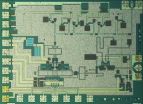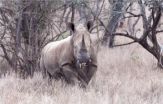World record in data transmission with smart circuits
2014-10-21
(Press-News.org) Fewer cords, smaller antennas and quicker video transmission. This may be the result of a new type of microwave circuit that was designed at Chalmers University of Technology. The research team behind the circuits currently holds an attention-grabbing record. Tomorrow the results will be presented at a conference in San Diego.
Every time we watch a film clip on our phone or tablet, an entire chain of advanced technology is involved. In order for the film to start playing in an even sequence when we press the play button, the data must reach us quickly via a long series of devices, antennas and receivers. With an increasing number of users, higher demands on image quality and more wireless systems, producing methods for transmitting the enormous amounts of data through the air with the right speed poses a major challenge.
The solution might be to use higher frequencies than today, from 100 Gigahertz and higher, since this would give access to a larger band of empty frequencies, enabling a higher data rate. Researchers all over the world are working to produce data circuits that can transmit and receive signals that are strong enough at higher frequencies. A Swedish group from Chalmers University of Technology and Ericsson has already been successful.
"We have designed circuits for signals at 140 Gigahertz, where we have a large bandwidth. In laboratory testing, we have achieved a transmission rate of 40 Gigabit data per second, which is twice as fast as the previous world record at a comparable frequency," says Herbert Zirath, who is a professor in high speed electronics at Chalmers. He is also employed by Ericsson Research on a part-time basis.
As a result of the record, the researchers have been asked to talk about their results together with a few other researchers under the heading "Breaking News" on Wednesday at the Compound Semiconductor Integrated Circuits Symposium conference in San Diego.
"Just being asked to present research results at the conference at all is a mark of quality. For our research to then be selected as one of the most important items to be presented as breaking news is naturally huge."
Herbert Zirath says that semiconductor materials development has enabled manufacture of circuits that can transmit high frequency signals with sufficiently high power. The circuits, which are made of the semiconductor material indium phosphide, are so small that a microscope is needed to distinguish the details.
Some of the applications for quicker wireless data transmission that Herbert Zirath envisions include major cultural and sports events where high-resolution live films need to be transmitted to screens without any delay or long cables, and communication within and between the large computer rooms where our digital files end up when we place them in "the cloud". Improved wireless transmission can also mean fewer cords in our homes and at our workplaces. The quick circuits are of interest to Ericsson in terms of transmitting signals to and from base stations and cellular towers.
"This is a very exciting area to be involved in, since the heavily increasing amount of data demands new solutions all the time. The fact that an increasing number of people are watching films wirelessly is the primary reason underlying the need for quicker transmission today."
The project is being funded by the Swedish Foundation for Strategic Research, and the next step for the project's researchers involves moving from the laboratory to the outdoors to test the circuits under real circumstances. Even though there are many aspects that have to fall into place for successful data transmission, Herbert Zirath is not nervous. Within a few years, the goal within the project is to demonstrate wireless data transfer of 100 Gigabit per second.
"I believe it is only a matter of a couple of years before our circuits will be used in practical applications."
INFORMATION:
[Attachments] See images for this press release:

ELSE PRESS RELEASES FROM THIS DATE:
2014-10-21
An experimental drug currently being trialled for influenza and Ebola viruses could have a new target: norovirus, often known as the winter vomiting virus. A team of researchers at the University of Cambridge has shown that the drug, favipiravir, is effective at reducing – and in some cases eliminating – norovirus infection in mice.
Norovirus is the most common cause of gastroenteritis in the UK. For most people, infection causes an unpleasant but relatively short-lived case of vomiting and diarrhoea, but chronic infection can cause major health problems for ...
2014-10-21
Amsterdam, October 21, 2014 – Flu vaccines are known to have a protective effect against heart disease, reducing the risk of a heart attack. For the first time, this research, published in Vaccine, reveals the molecular mechanism that underpins this phenomenon. The scientists behind the study say it could be harnessed to prevent heart disease directly.
Heart disease is the leading cause of death worldwide. People can reduce their risk of heart disease by eating healthily, exercising and stopping smoking. However, to date there is no vaccine against heart disease.
Previous ...
2014-10-21
Cosmologists have made the most sensitive and precise measurements yet of the polarization of the cosmic microwave background.
The report, published October 20 in the Astrophysical Journal, marks an early success for POLARBEAR, a collaboration of more than 70 scientists using a telescope high in Chile's Atacama desert designed to capture the universe's oldest light.
"It's a really important milestone," said Kam Arnold, the corresponding author of the report who has been working on the instrument for a decade. "We're in a new regime of more powerful, precision cosmology." ...
2014-10-21
The extinction in the wild of the southern white rhino population could be prevented by letting local communities take responsibility of the animals and giving them permission to harvest horns in a controlled manner through a legal trade. Rhino horn is made of the same material as human hair and fingernails and grows back in 2–3 years.
In 2013, more than 1000 rhinos were killed illegally for their horns in South Africa. Rhino horns are being used in Asia for traditional Chinese medicine and personal prestige. Now, a new study based on ecological and socio-economic ...
2014-10-21
NASA's newest orbiter at Mars, MAVEN, took precautions to avoid harm from a dust-spewing comet that flew near Mars today and is studying the flyby's effects on the Red Planet's atmosphere.
The MAVEN spacecraft -- full name Mars Atmosphere and Volatile Evolution -- reported back to Earth in good health after about three hours of precautions against a possible collision with high-velocity dust particles released by comet C/2013 A1 Siding Spring.
"We're glad the spacecraft came through, we're excited to complete our observations of how the comet affects Mars, and we're ...
2014-10-21
October 20, 2014 – (BRONX, NY) – Rates of depression and anxiety vary widely among different segments of the U.S. Hispanic and Latino population, with the highest prevalence of depressive symptoms in Puerto Ricans, according to a new report from Albert Einstein College of Medicine of Yeshiva University and the Hispanic Community Health Study/Study of Latinos (HCHS/SOL). The researchers' findings also suggest that depression and anxiety may be undertreated among Hispanics and Latinos, particularly if they are uninsured. The study was published online in Annals ...
2014-10-21
Our species' waking and sleeping cycles – shaped in millions of years of evolution – have been turned upside down within a single century with the advent of electric lighting and airplanes. As a result, millions of people regularly disrupt their biological clocks – for example, shift workers and frequent flyers – and these have been known to be at high risk for such common metabolic diseases as obesity, diabetes and heart disease. A new study published in Cell, led by Weizmann Institute scientists, reveals for the first time that our biological clocks ...
2014-10-21
Bethesda, MD (Oct. 21, 2014) — If you are not getting the recommended seven-to-eight hours of sleep each night, you may be at increased risk of developing ulcerative colitis, according to a new study1 in Clinical Gastroenterology and Hepatology, the official clinical practice journal of the American Gastroenterological Association.
"Both short and long durations of sleep have important health implications and are associated with increased overall mortality, cardiovascular disease and cancer," said lead study author Ashwin N. Ananthakrishnan, MD, MPH, Massachusetts ...
2014-10-21
A team of UC San Francisco researchers has found that a tiny segment of genetic material known as a microRNA plays a central role in the transition from moderate drinking to binge drinking and other alcohol use disorders.
Previous research in the UCSF laboratory of Dorit Ron, PhD, Endowed Chair of Cell Biology of Addiction in Neurology, has demonstrated that the level of a protein known as brain-derived neurotrophic factor, or BDNF, is increased in the brain when alcohol consumed in moderation. In turn, experiments in Ron's lab have shown, BDNF prevents the development ...
2014-10-21
(Vienna, October 21, 2014) Patients with irritable bowel syndrome (IBS) may at last be able to hope for a brighter future as innovative new treatments emerge and researchers clarify the role of current therapies. Dr Alexander C. Ford from the Leeds Gastroenterology Institute in Leeds, UK, tells journalists attending the 22nd United European Gastroenterology Week (UEG Week 2014) in Vienna, Austria, that significant progress was being made in drug development for IBS, thanks to the intense research efforts of scientists around the world. "Researchers have dedicated many years ...
LAST 30 PRESS RELEASES:
[Press-News.org] World record in data transmission with smart circuits


